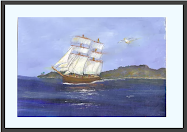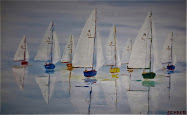El S.S. Valencia
The SS Valencia was an iron-hulled passenger steamer wrecked off the coast of Vancouver Island, British Columbia in 1906. Built in 1882 by William Cramp and Sons, she was 252 feet (77 m) in length and weighed 1,598 tons.[1] Some consider the wreck of the Valencia to be the worst maritime disaster on the southwest coast of Vancouver Island, an area so treacherous it was known to mariners as the Graveyard of the Pacific.[2][3]
Final Voyage
The Valencia normally served the California–Alaska route. In January 1906, however, she was temporarily diverted to the San Francisco–Seattle route to take over from the SS City of Puebla, which was undergoing repairs in San Francisco. The weather in San Francisco was clear, and the Valencia set off on January 20 at 11:20 AM with nine officers, 56 crew members and at least 108 passengers aboard.[1] As she passed by Cape Mendocino in the early morning hours of January 21, the weather took a turn for the worse. Visibility was low and a strong wind started to blow from the southeast.
Unable to make celestial observations, the ship's crew was forced to rely on dead reckoning to determine their position.[3] Out of sight of land, and with strong winds and currents, the Valencia overshot the entrance to the Strait of Juan de Fuca by more than 20 miles (30 km). Shortly before midnight on January 22, she struck a reef near Pachena Point on the southwest coast of Vancouver Island.
Collision and Disaster
Immediately after the collision, the captain ordered her engines reversed. As soon as she was clear of the rocks, crew members reported a large gash in the hull into which water was pouring rapidly. To prevent her from sinking, the captain ordered her run aground, and she was driven into the rocks again. She was left stranded in sight of the shore, separated from it by 50 metres of heavy surf.[3]
In the ensuing confusion, six of the ship's seven lifeboats were lowered into the water against the captain's orders, all of them improperly manned. Three flipped while being lowered, spilling their occupants into the ocean; of the three that were successfully launched, two capsized and one disappeared. Only 12 men made it to shore, and of those three were washed away by the waves after landing. The remaining nine men scaled the cliffs and found a telegraph line strung between the trees. They followed the line through thick forest until they came upon a lineman's cabin, from which they were able to summon help.[1]
Meanwhile, the ship's boatswain and a crew of volunteers had been lowered in the last remaining lifeboat with instructions to find a safe landing place and return to the cliffs to receive a lifeline from the ship. Upon landing, they discovered a trail and a sign reading "Three miles to Cape Beale." Abandoning the original plan, they decided to head toward the lighthouse on the cape, where they arrived after 2 ½ hours of hiking. The lighthouse keeper phoned Bamfield to report the wreck, but the news had already arrived and been passed on to Victoria.[1
Rescue Efforts
Once word of the disaster reached Victoria, three ships were dispatched to rescue the survivors. The largest was the passenger liner SS Queen; accompanying her were the salvage steamer Salvor and the tug Czar. Another steamship, the SS City of Topeka, was later sent from Seattle with a doctor, nurses, medical supplies, members of the press, and a group of experienced seamen. On the morning of January 24, the Queen arrived at the site of the wreck, but was unable to approach due to the severity of the weather and lack of depth charts. Seeing that it would not be possible to approach the wreck from the sea, the Salvor and Czar set off to Bamfield to arrange for an overland rescue party.[3]
Upon seeing the Queen, the Valencia's crew launched the ship's two remaining life rafts, but the majority of the passengers decided to remain on the ship, presumably believing that a rescue party would soon arrive. Approximately one hour later, the City of Topeka arrived and, like the Queen, was unable to approach the wreck. The Topeka cruised the waters off the coast for several hours searching for survivors, and eventually came upon one of the life rafts carrying 18 men. No other survivors were found, and at dark the captain of the Topeka called off the search. The second life raft eventually drifted ashore on an island in Barkley Sound, where the four survivors were found by the island's First Nations and taken to a village near Ucluelet.[1]
When the overland party arrived at the cliffs above the site of the wreck, they found dozens of passengers clinging to the rigging and the few unsubmerged parts of the Valencia's hull. Without any remaining lifelines, however, they could do nothing to help the survivors, and within hours a large wave washed the wreckage off the rocks and into the ocean. Every remaining passenger drowned.[3]
Investigation and Aftermath
Within days of the disaster, the US Marine Inspection Service launched an investigation into the incident. A second investigation was launched by President Theodore Roosevelt. Its purpose was twofold: one, to determine the causes of the disaster; and two, to recommend how to avoid such loss of life in the future. The investigation ran from February 14 to March 1, 1906, and the final report was published on April 14, 1906. The reports agreed on the causes of the disaster – navigational mistakes and poor weather. Safety equipment was, for the most part, in working order, but lifeboat drills had not been carried out. According to the report, the crew of the rescuing vessels did as much to help the Valencia as could be expected under the circumstances.[1]
The loss of life was attributed to a series of unfortunate coincidences, aggravated by a lack of lifesaving infrastructure along Vancouver Island's coast. The federal report called for the construction of a lighthouse between Cape Beale and Carmanah Point, and the creation of a coastal lifesaving trail with regularly spaced shelters for shipwrecked sailors. It also recommended that surfboats to be stationed at Tofino and Ucluelet and that a well-equipped steamboat be stationed at Bamfield. The Canadian government immediately set to work building a lighthouse and trail; in 1908, the Pachena Point Lighthouse was lit, and in 1911 work on the trail – later known as the West Coast Trail – was completed.[3][4]
Estimates of the number of lives lost in the disaster vary widely; some sources list it at 117, while others claim it was as high as 181.[2][5] According to the federal report, the official death toll was 136 persons. Only 37 men survived, and every woman and child on the Valencia died in the disaster.
In 1933, 27 years after the disaster, the Valencia's lifeboat #5 was found floating in Barkley Sound. Remarkably, it was in good condition, with much of the original paint remaining.[2][6] The boat's name plate is now on display in the Maritime Museum of British Columbia.[1]
The Valencia's dramatic end has made it the subject of several local rumours and ghost stories. Five months after the incident, a local fisherman claimed to have seen a lifeboat with eight skeletons in a nearby sea cave, but the party dispatched to investigate was unable to locate the cave. In 1910, the Seattle Times reported that sailors claimed to have seen a phantom ship resembling the Valencia near Pachena Point.[2]
l SS Valencia fue un barco de vapor que naufragó frente a la costa
de Vancouver, en la Columbia británica en 1906. El navío se encontró
con mal tiempo cerca del cabo Mendocino y después de irse a la deriva,
golpeó un arrecife, abriendo en su casco una vía de agua. La tripulación
se refugió en los botes salvavidas, quedándose 108 pasajeros a bordo,
pero algunos zozobraron y otros simplemente desaparecieron. El SS
Valencia se hundió finalmente y solo 37 de los aproximadamente 180
pasajeros sobrevivieron. Cinco meses después, un pescador encontró un
bote salvavidas con 8 esqueletos en una cueva cercana. La búsqueda se
puso en marcha, pero no se encontró nada.
Gracias a su dramático final, el SS Valencia se convirtió en la fuente de numerosas historias de barcos fantasma. A veces los marineros afirman que pueden ver el espectro del vapor a la deriva cerca del arrecife en Pachena Point y hasta el día de hoy, el barco es la fuente de descabelladas teorías y avistamientos de buques fantasmas. Extrañamente, 27 años después del hundimiento del SS Valencia, uno de los botes salvavidas fue encontrado flotando pacíficamente en las inmediaciones de Barkley Sound. Se decía que “la barca fantasma” estaba en una condición notable, e incluso conservaba la mayor parte de la estructura original de la pintura.
Fuente: http://www.geekets.com/

Gracias a su dramático final, el SS Valencia se convirtió en la fuente de numerosas historias de barcos fantasma. A veces los marineros afirman que pueden ver el espectro del vapor a la deriva cerca del arrecife en Pachena Point y hasta el día de hoy, el barco es la fuente de descabelladas teorías y avistamientos de buques fantasmas. Extrañamente, 27 años después del hundimiento del SS Valencia, uno de los botes salvavidas fue encontrado flotando pacíficamente en las inmediaciones de Barkley Sound. Se decía que “la barca fantasma” estaba en una condición notable, e incluso conservaba la mayor parte de la estructura original de la pintura.
Fuente: http://www.geekets.com/
















1 comentario:
Guillermo: he visitado su blog, y me resultó apasionante. Cuidada redacción y muy buena selección de temas de historia náutica, lo felicito y espero seguir leyendo tan buenos posts. Un gran saludo desde Rosario.
Publicar un comentario